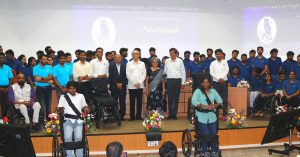The Tweeter Side to Life: How Indians on Twitter Are Making a Difference
The truly incredible stories that unfold on Twitter are narratives involving ordinary folk who turn to the little blue bird to cut through red tape.

Find out how Twitter India has been helping Twitterati dole out social change 140 characters at a time.
Tweets flutter across desi airspace like it’s migration season all year round.
Whether it’s a celebrity telling cyber bullies to back off, or our very own external affairs minister delivering sweet relief to her 7 million followers, Twitter has equipped millions of Indians with the ability to speak out and be heard.
But the truly incredible stories that unfold on the social media site are narratives involving ordinary folk who turn to the little blue bird to cut through red tape.
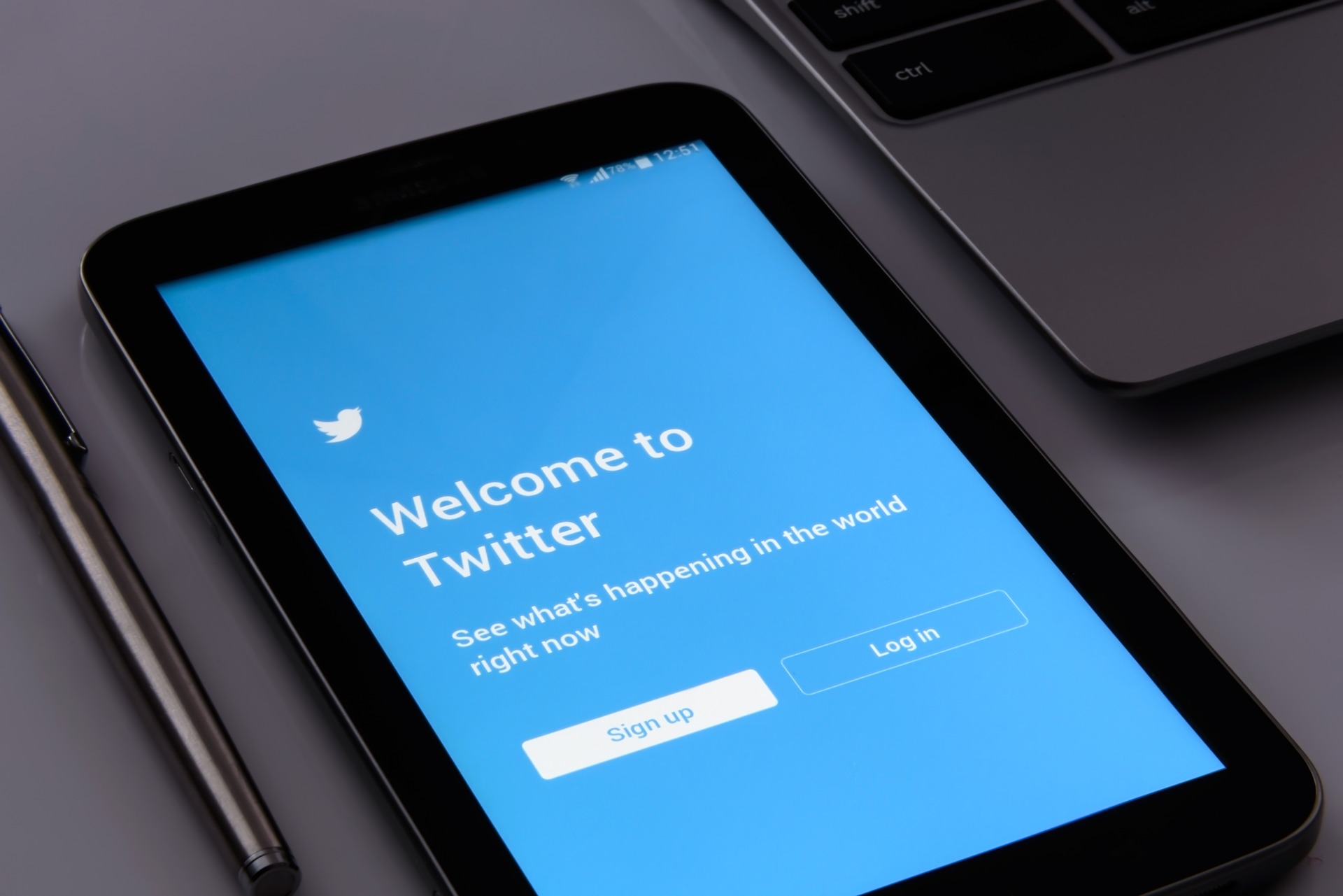
In 2016, a simple tweet calling attention to starving baby rhinos at the Kaziranga National Park, orphaned due to the devastating Assam floods, received an outpouring of support. Almost immediately, food and drink conglomerate Nestle India sent help on the way, sponsoring 103 cartons of milk towards relief efforts.
Shortly after, airline Spice Jet volunteered to fly the cargo for free to Jorhat, with the entire dispatch being live-tracked by tweets at every stage of the process.

Then there was the case of UP-based Hindi weekly Khabar Lahariya. For nine months, formal complaints regarding a serial stalker targeting the newspaper’s female reporters lodged at local police stations went completely ignored. Then webzine The Ladies Finger reported the story.
Within 48 hours, the culprit was arrested, thanks to a chain of tweets that saw the story shared on Twitter, the chief minister’s office tagged and the Banda police directly called to action by the state government.

Even critics of the “governance-via-Twitter” genre of public service cannot deny that the micro-blogging site’s format allows for unprecedented effectiveness, so much so that tweeting to subvert formal channels of communication is fast becoming the norm, rather than the exception.
Take the case of disability rights activist Nipun Malhotra, who tweeted about being denied access to Keya, a popular restaurant at Delhi’s DLF Promenade mall, because he was disabled.
#ShameOnKeya began trending immediately after, with indignant followers voicing their concerns until an apology and explanation was issued by the establishment and MP Derek O’Brien, who was alerted on Twitter, promised to bring the issue up in Parliament.
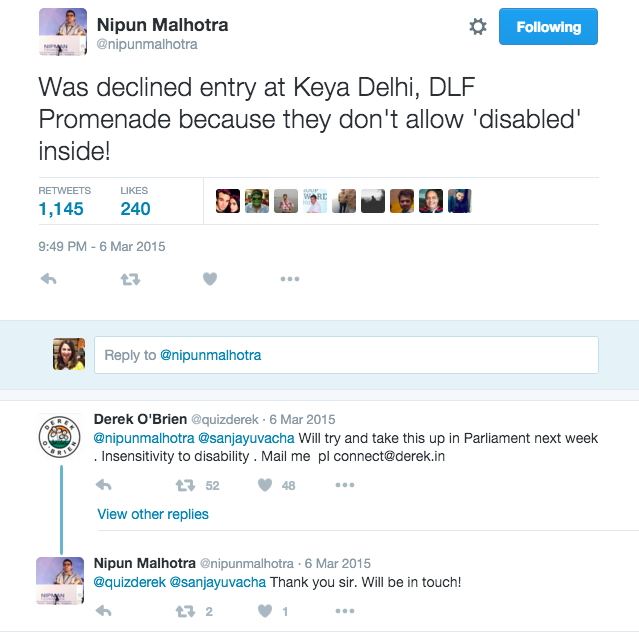
If you’re looking in the right places, a short time on Twitter will unearth scores of stories of this sort, all hashtagging as newfound outlets for contemporary free speech: #UdtaPunjabCensored that saw the film fraternity and common cinema-goers unite to decry the decision made by the Censor Board; #INeverAskForIt, an outcry used by women across the board as a retort to rhetoric that places the blame for crimes against women on their attire; and #MyRightToBreathe protesting smog in the national capital.
It takes the mere tap of a keypad to follow someone on Twitter; contacting them is as simple as tweeting at them. As a result, the social media site is also fast-gaining a reputation as a system that provides the common man with access to the highest echelons of government officials, public servants and corporates.
In the past, Twitter has been credited with providing a news-hungry world with informal reportage from areas that have slipped under the radar of mainstream journalism.
Today, not even state-of-the-art analytics can tangibly calculate the extent of its outreach.
#TwitterForGood
Author J.K. Rowling regularly uses Twitter as an anti-establishment loudspeaker. Others, like American fast food chain Wendy’s, routinely serve up piping hot Twitter sass as a marketing tactic to keep the competition on its toes.
But look beyond the wit and wile for yet another category of Twitter users, and you will find a whole faction that turns to the micro-blogging site for solace and support.
Feeding India, an award-winning not-for-profit, operates right on the Twitter frontlines to get more people involved in their battle against hunger and malnutrition. Till date, the youth network has served 1.8 million meals to people in need by mobilising 2,500 volunteers across 35 cities. Their mission owes its success, in significant part, to Twitter. They describe how they use the platform to engage with potential volunteers, donors and partners and also frequently conduct live Q&A sessions to give followers a chance to learn more about ongoing projects and upcoming plans.
They’re not alone.
Sanket Patil of SheSays, an NGO that works to educate, rehabilitate and empower women to speak out against sexual abuse and gender inequality, describes how his organisation received “an outpouring of support” on the #DontTaxMyPeriod Twitter campaign that called to make feminine hygiene products tax-free.
He reveals that he first encountered SheSays on Twitter himself, adding,
“We believe we are successful in doing what we set out to do when survivors reach out to us for help and support on Twitter as someone they can trust.”

Still others, such as Madhya Pradesh-based NGO Aham Bhumika, use Twitter to sell crafts and clothes made by underprivileged and tribal women in need of employment.
Philanthropic efforts like theirs haven’t gone unnoticed. Instead, Twitter India has stepped up with an initiative of its own specifically aimed at assisting social workers develop dedicated strategies for their organisations to fully exploit features available on the platform.
Through Twitter 101 (and 102) Workshops, Twitter India provides NGOs with free, educational sessions that go a long way in helping them achieve targets. While some aim at increasing the numbers of followers they have online, others choose to focus on making the right connections. Either way, a successful strategy involves a clear understanding of the medium and the different tools it offers by way of technology.
Mahima Kaul, Head of Policy at Twitter India, explains, “A lot of the bigger NGOs are well-oiled machines when it comes to Twitter and have access to celebrities who are happy to help them out with retweets. Smaller NGOs know that they can use Twitter as a tool, but lack self confidence. Something that we focus on in our Twitter workshops is letting people know that there is an audience for everything. You just have to make sure you’re reaching that audience by understanding how to frame your tweets and using the right hashtags.”
Feeding India describes how it was able to put training into practice in 2016, post Twitter 101, when its founder Ankit Kawatra visited the United Nations General Assembly and used Twitter Mirror, a live Twitter platform for event coverage, at the UNHQ.

Since the workshop, it says, it has noticed a “steep increase in engagement.”
Others, such as Oxfam India, BitGiving and InCrisisRelief have recognised the vast capacity of the platform in assisting crisis and disaster relief efforts. Emergency situations have witnessed unprecedented levels of collaboration between NGOs such as theirs, citizens, government agencies and the media, who use the platform to broadcast stories from the ground, provide live updates and coordinate relief efforts.
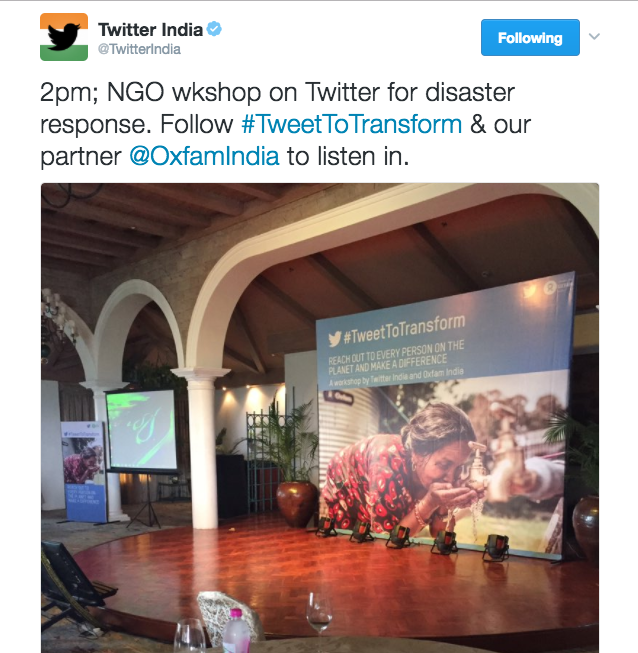
For The Tweeple, By The Tweeple, Of The Tweeple
Social media, that great equalising force that puts the likes of @PakaluPapito right next to @realDonaldTrump, reflects a fluid, millennial reality: that of necessitated democracy.
Mahima points out a differentiating aspect of Twitter as a platform, one that, she believes, makes its usage unique. “The wonderful thing about Twitter is that it really is interest-based. Most Twitter users don’t even follow their friends on Twitter, they use it to connect with people who share their interests and ideas.
“The difference between Twitter and other social media platforms is that we don’t curate your feed for you. There is no algorithm. So your feed truly reflects what you like and follow.”
By displaying content only from sources users have chosen to follow, most people develop networks that remain organic and engaged.
Whether it is those who turn to Twitter for trivial slice-of-life commentary, like this user who live tweeted a real-time boy-meets-girl-on-train story, or others who seek speedy consumer assistance from corporate giants, there is something for everyone.
Among the melee of virtual voices travelling the twitterverse, there are those increasingly using it to champion social change. Once more, Twitter is at the forefront, supporting these initiatives.
For instance, a popular series developed by Twitter India has been the #PositionOfStrength initiative that aims to take campaigns for gender equality to digital spaces. The series has brought together women influencers, including Kiran Bedi, Priyanka Chaturvedi and Anjum Chopra, to discuss how they actively use their Twitter accounts to drive awareness about topics like the pay gap, childcare, domestic violence, healthcare and flexible work, and inspire others to do the same.

Another campaign is the #TweeSurfing programme, developed by the Center for Social Research India (CSR) in collaboration with Twitter, aimed at promoting online safety among millennials, among other things.
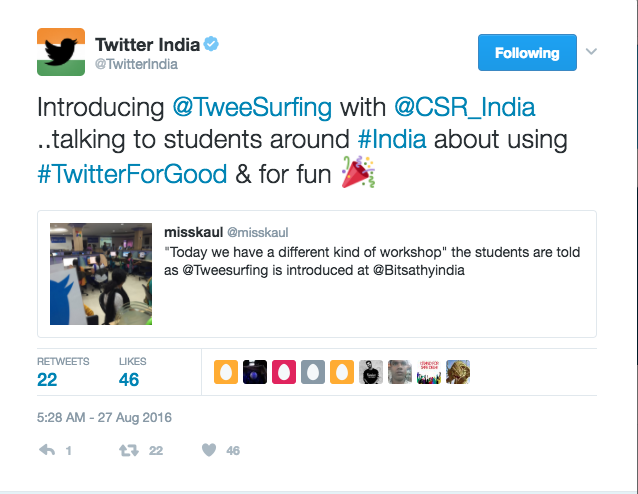
Amitabh Kumar, Head of Media and Communications at CSR says, “Twitter has evolved as a tool for empowerment in India. #TweeSurfing aims to work with young people to use their skills for social change. During our workshops we had amazing inputs from college students on the campaigns they would like to design. It’s early days but we see a tremendous potential of Twitter in India as more Indians get online.”
Sanket concurs, citing the support SheSays has received because of Twitter. “We engage volunteers from remote areas in order to spread awareness and ensure accessibility. It is heartening to see the amount of people willing to do their part in making the country and world a better place.”
While there are those who actively seek to wield Twitter as a powerful, modern tool of engagement, for many voices mobilised by the platform, the freedom afforded by the medium itself is the message.
Like this story? Or have something to share? Write to us: [email protected], or connect with us on Facebook and Twitter.
NEW: Click here to get positive news on WhatsApp!
This story made me
-
97
-
121
-
89
-
167
Tell Us More
We bring stories straight from the heart of India, to inspire millions and create a wave of impact. Our positive movement is growing bigger everyday, and we would love for you to join it.
Please contribute whatever you can, every little penny helps our team in bringing you more stories that support dreams and spread hope.






